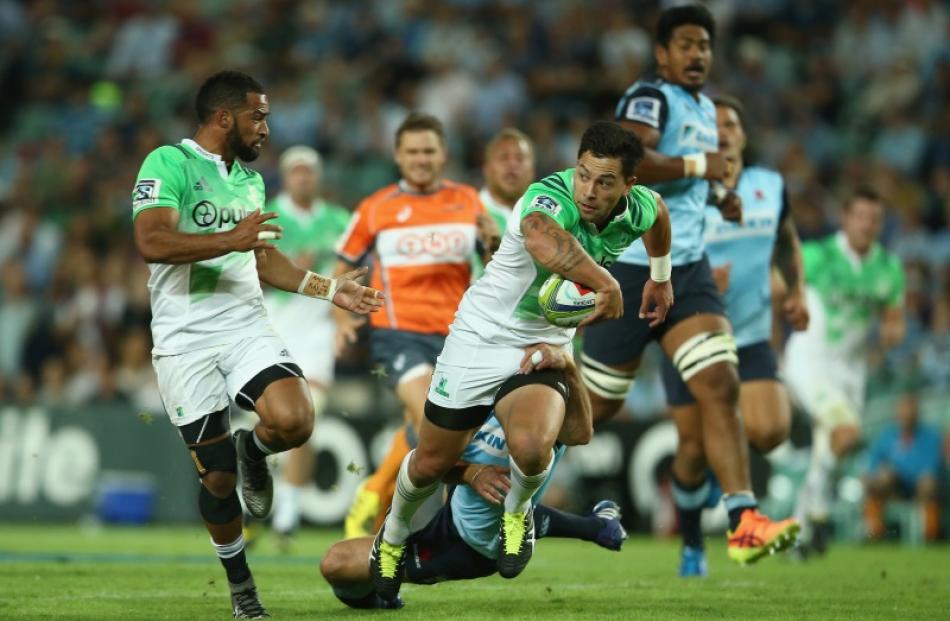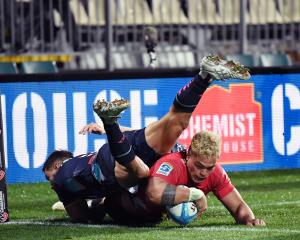Otago Daily Times Online rugby writer Jeff Cheshire looks at some key points from the Highlanders' 30-26 win over the Waratahs in Sydney on Friday night.
Energy on defence
The Highlanders' defensive energy was the telling factor in the game. For the first three-quarters they were outstanding in this area and it reflected in their overall dominance. Their line speed was fantastic, as they got up fast to shut down the Waratahs' space, but their aggressive tackling and fast reset for the next phase was equally important. Not only did the Waratahs struggle to make the gain line, they often went backwards as they set with more depth to alleviate the Highlanders' pressure. It was that pressure that created a plethora of mistakes, which the Highlanders' took full advantage of. The later stages of the game saw the Highlanders line speed slow and their hits become less aggressive. That saw the Waratahs get more go-forward and cut back on mistakes, which in turn made them harder to defend.
What happened in the last 25 minutes?
A dream performance nearly turned into a nightmare as the Waratahs rapidly closed on a 30-0 lead. Undoubtedly the defensive intensity dropped from the Highlanders, but it is no good pointing that out without finding the reason for it. Things became messier when changes were made, as they often do, and the team did not click as a collective. Fatigue could come into it, as they were playing a high intensity for much of the game, which is inevitably going to tire you. The Highlanders are a fit team though and did use their bench. Often when you get such a big lead, it can be hard to remain up and ready. That can let opponents back into games. The trouble is, once you switch off and momentum shifts, it is hard to get back into it. That showed, as once the Waratahs became rampant, it was hard to deny them front foot ball and gaps opened up everywhere.
Turning defence into attack
For the second week in a row, the Highlanders showed their ability to capitalise after turning over ball. Both the second and third tries came as the Waratahs coughed up possession, with the Highlanders getting the ball into space quickly. That space came in either gaps in the line or in behind for a kick chase. It is hard to stop a team who does this well and the Highlanders are one which certainly fits that bill.
Multidimensional forward pack
The Highlanders' forward pack was outstanding and showed their array of abilities. They worked hard all night, getting around the field and off the mark on defence with pace, while also bringing physicality in contact. But they are far from just a pack of workers. In the open they excelled, with the loose forwards in particular impressing. Elliot Dixon showed his range of skills by running dangerously, offloading in space, chasing kicks and successfully winning a cross-field bomb in the lead up to his second try. Liam Squire was equally good, running well in open field and combining with Liam Coltman to score a try from 45m out. How many other teams could say they score tries from that far out with only two forwards involved? Coltman himself kept popping up in the loose, while Gareth Evans was good in the ranging role when he came on.
Were they really tries?
The only obvious reasoning for awarding the Waratahs' third try, when Tom Robertson stole the ball from the wrong side after a tackle, was that a ruck a had not formed and Robertson was a tackler. World Rugby defines a ruck as "a phase of play where one or more players from each team, who are on their feet, in physical contact, close around the ball on the ground". In this case it could be argued that those involved in the contact were tacklers and not on their feet, meaning no ruck had formed.
However, to contest the ball without coming through the gate, Robertson would have needed to be the tackler. While he was involved in the tackle, along with several others, he seemed to leave the contact early and did not hold Liam Squire to the ground. Therefore he surely must have been required to come through the gate. The second controversial try, from the maul, was more of a 50-50. The ball looked to be on the line, although it was not clear who was in possession of it.
Strong set-piece
When the Highlanders went to Sydney two years ago, they were given a lesson at scrum time. They have come a long way though and were dominant in that area, as they have been in recent weeks. Most encouraging is that they seem to be excelling through having a strong push, meaning they can scrum legally and not have to revert to tactics to mess up the opponent's scrum to be dominant. The lineout became disjointed towards the end, but operated well for most of the game and Elliot Dixon did a good job of stealing ball towards the front.
Kicking game
The Highlanders once again made use of the kicking game that proved so effective in last year's semifinal against the Waratahs. Their kicks varied between long and high, with the odd chip thrown in. With that they found space, or applied pressure through a fast chase, which saw the Waratahs have to bring the ball back from their own half regularly.












